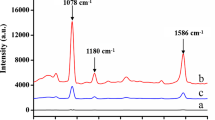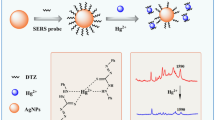Abstract
Quantitative characterization of Cr3+, an important element revealing human metabolism and biological environmental variation, is still difficult to achieve by conventional biochemical methods due to the lack of high-sensitivity, real-time techniques with rapid response detection. Using surface-enhanced Raman scattering (SERS), we construct an Au/Ag composite-based SERS nanoprobe for the quantitative characterization of Cr3+ content in solution, in which DL-mercaptosuccinic acid (DL-MSA) is employed for Raman signal enhancement, and 4-mercaptobenzoic acid (4-MBA) is chosen as the Raman reporter. The achieved result demonstrates obvious advantages of the synthesized Au/Ag composite-based SERS nanoprobe in sensitivity and response speed. Importantly, this Au/Ag composite-based SERS nanoprobe might provide a new strategy for dynamic monitoring of Cr3+ content in human metabolism.
Graphical abstract











Similar content being viewed by others
References
Yu Y, Ying H, Wang Y, Xiangying S, Bin L. Mecaptosuccinic acid modified gold nanoparticles as colorimetric sensor for fast detection and simultaneous identification of Cr3+[J]. Sens Actuators B. 2017;239:865–73.
Wang N, Gang L, Shouzhi P, Erting F, Congbin F. A Highly Selective Diarylethene Chemosensor for Colorimetric Detection of Cn− and Fluorescent Relay-Detection of Al3+/Cr3+[J]. Dyes Pigm. 2018;151:22–7.
Manjubaashini N, Thangadurai TD, Bharathi G, Nataraj D. Rhodamine Capped Gold Nanoparticles for the Detection of Cr3+ Ion in Living Cells and Water Samples[J]. J Lumin. 2018;202:282–8.
Xu H, Ding H, Fan C, Liu G, Shouzhi P. A Multi-Responsive Diarylethene-Rhodamine 6G Derivative for Sequential Detection of Cr3+, and Co32−[J]. Tetrahedron. 2018;74:3489–97.
Levina A, Pham THN, Lay PA. Binding of Chromium(III) to Transferrin Could be Involved in Detoxification of Dietary Chromium(III) Rather than Transport of an Essential Trace Element[J]. Angew Chem. 2016;128(28):8236–9.
Deng G, Dyroff SL, Lockart M, Bowman MK, Vincent JB. The Effects of the Glycation of Transferrin on Chromium Binding and the Transport and Distribution of Chromium In Vivo. [J]. J Inorg Biochem. 2016;164:26–33.
Saha PMS, Suresh E, Di Liddo R, Parnigotto PP, Conconi MT, Kesharwani MK, et al. Ratiometric Detection of Cr3+ and Hg2+ by a Naphthalimide-Rhodamine Based Fluorescent Probe[J]. Inorg Chem. 2012;51:1769–77.
Alahmad W, Tungkijanansin N, Kaneta T, Varanusupakul P. A colorimetric paper-based analytical device coupled with hollow fiber membrane liquid phase microextraction (HF-LPME) for highly sensitive detection of hexavalent chromium in water samples[J]. Talanta. 2018;190:78–84.
Lo S-H, Wu M-C, Venkatesan P, Shu-Pao W. Colorimetric detection of chromium(III) using O-phospho-l-serine dithiocarbamic acid functionalized gold nanoparticles[J]. Sens Actuators B. 2015;220:772–8.
Zare-Moghadam M, Shamsipur M, Molaabasi F, Hajipour-Verdom B. Chromium speciation by isophthalic acid-doped polymer dots as sensitive and selective fluorescent probes[J]. Talanta. 2019. https://doi.org/10.1016/j.talanta.2019.120521.
Yin H, Zhao B, Kan W, Liu T, Wang W, Yin G, et al. Hydroxyl phenyl imino modified phenanthro[9,10-d] imidazole: An AIEE-active sensor for determination of Cu2+ in water samples and subsequent “turn-on” recognition of Cr3+ with logic gates[J]. Spectrochimica Acta Part A. 2019;217:18–26.
Ohira S-I, Nakamura K, Chiba M, Dasgupta P, Toda K. Matrix isolation with an ion transfer device for interference-free simultaneous spectrophotometric determinations of hexavalent and trivalent chromium in a flow-based system[J]. Talanta. 2016;164:445–50.
Xiao M, Shen H, Qiangqiang F, Xiao W, Bian H, et al. Practical immune-barometer sensor for trivalent Chromium Ions detection using gold core platinum shell nanoparticles Probes[J]. The Analyst. 2018. https://doi.org/10.1039/C7AN02047C.
Filik H, Avan AA. Magnetic nanostructures for preconcentration, speciation and determination of chromium ions: A review[J]. Talanta. 2019;203:168–77.
Pechancová R, Gallo J, Milde D. Ion-exchange HPLC-ICP-MS: A Ultrasensitive Detection of Lung Cancer Cells and Their Biomarkers[J]. ACS Sustainable. Chem Eng. 2019;7(5):5200–8.
Xu S, Tang W, Chase DB, Sparks DL, Rabolt JF. A Highly Sensitive, Selective, and Reproducible SERS Sensor for Detection of Trace Metalloids in The Environment[J]. ACS Appl Nano Mater. 2018;1(3):1257–64.
Wang J, Wu X, Ma W, Xu C. Chiral AuCuAu Heterogeneous Nanorods with Tailored Optical Activity[J]. Adv Funct Mater. 2020. https://doi.org/10.1002/adfm.202000670.
Xiuli F, Wen J, Li J, Lin H, Liu Y, Zhuang X, et al. Highly Sensitive Detection of Prostate Cancer Specific PCA3Mimic DNA Using SERS-based Competitive Lateral Flow Assay[J]. Nanoscale. 2019;11:15530–15,536.
Wang S, Liu Z, Bartic C, Xu H, Ye J. Improving SERS uniformity by isolating hot spots in gold rod-in-shell nanoparticles[J]. Nanopart Res. 2016;18(8):1–11.
Tian F, Conde J, Bao C, Chen Y, Curtin J, Cui D. Gold Nanostars for efficient in Vitro and in Vivo Real-Time SERS Detection and Drug Delivery via Plasmonic-Tunable Raman/FTIR Imaging[J]. Biomaterials. 2016;106:87–97.
Jainpk E-SM. Plasmonic coupling in noble metal nanostructures[J]. Chem Phys Letters. 2010;487(4–6):153–64.
Bi N, Chen Y, Qi H, Zheng X, Yang C, Xue L, et al. Spectrophotometric determination of mercury(II) ion using gold nanorod as probe[J]. Sensor Actuat B-Chem. 2012;166–167:766–71.
Tan MJ, Hong Z-Y, Chang M-H, Liu C-C, Cheng H-F, Loh XJ, et al. Metal carbonyl-gold nanoparticle conjugates for highly sensitive SERS detection of organophosphorus pesticides[J]. Biosens Bioelectron. 2017;96:167–72.
Narayanan KB, Park HH. Colorimetric detection of manganese(II) ions using gold/dopa nanoparticles[J]. Spectrochim Acta A. 2014;131:132–7.
Njoki PN, Roots MED, Maye MM. The Surface Composition of Au/Ag Core/Alloy Nanoparticles Influences the Methanol Oxidation Reaction[J]. ACS Appl Nano Mater. 2018;1(10):5640–5.
Xie Y, Chen T, Guo Y, Cheng Y, He Q, Yao W. Rapid SERS detection of acid orange II and brilliant blue in food by using Fe3O4@Au core–shell substrate[J]. Food Chem. 2019;270:173–80.
Ma Y, Liu H, Chen Y, Du YY, Gu C, Zhao Z, et al. Quantitative and Recyclable Surface-Enhanced Raman Spectroscopy Immunoassay Based on Fe3O4@TiO2@Ag Core-Shell Nanoparticles and Au Nanowire/Polydimethylsiloxane Substrates[J]. ACS Applied Nano Materials. 2020;3(5):4610–22.
Ma Y, Yuanyuan D, Chen Y, Chenjie G, Jiang T, Wei G, et al. Intrinsic Raman signal of polymer matrix induced quantitative multiphase SERS analysis based on stretched PDMS film with anchored Ag nanoparticles/Au nanowires[J]. Chem Eng J. 2019. https://doi.org/10.1016/j.cej.2019.122710.
Lu W, Wang Z, Li L, Zhang J, Liu J, Hu J, et al. Magnetic–plasmonic Ni@Au core–shell nanoparticle arrays and their SERS properties[J]. RSC Adv. 2020;10(5):2661–9.
Li H, Yue X, Gao N, Tang J, Lv X. Junwei Hou Microwave method synthesis of magnetic ionic liquid/gold nanoparticles as ultrasensitive SERS substrates for trace clopidol detection[J]. Anal Bioanal Chem. 2020;412:3063–71.
Yuanyuan D, Liu H, Chen Y, Tian Y, Zhang X, Chenjie G, et al. Recyclable label-free SERS-based immunoassay of PSA in human serum mediated by enhanced photocatalysis arising from Ag nanoparticles and external magnetic field[J]. Appl Surf Sci. 2020. https://doi.org/10.1016/j.apsusc.2020.146953.
Chen Y, Liu H, Tian Y, Du YY. In-situ recyclable SERS-based detection of multicomponent pesticide residues on fruits and vegetables by flower-like MoS2 @Ag hybrid substrate[J]. ACS Appl Mater Interfaces. 2020;12:14386–14,399.
Sun M, Zhao A, Wang D, Wang J, Wang J, Sun H. Cube-like Fe3O4@SiO2@Au@Ag magnetic nanoparticles: a highly efficient SERS substrate for detection of pesticide[J]. Nanotechnology. 2018. https://doi.org/10.1088/1361-6528/aaae42.
Muhammad M, Yao G, Zhong J, Chao K, Azizd MH, Huang Q. A facile and label-free SERS approach for inspection of fipronil in chicken eggs using SiO2@Au core/shell nanoparticles[J]. Talanta. 2019. https://doi.org/10.1016/j.talanta.2019.120324.
Samal AK, Polavarapu L, Rodal-Cedeira S, Liz-Marzán LM, Pérez-Juste J, Pastoriza-Santos I. Size Tunable Au@Ag Core–Shell Nanoparticles: Synthesis and Surface-Enhanced Raman Scattering Properties[J]. Langmuir. 2013;29(48):15076–15,082.
Li Y, Shi Q, Zhang P, Xiahou Y, Li S, Wang D, et al. Empirical structural design of core@shell Au@Ag nanoparticles for SERS applications[J]. J Mater Chem C. 2016;4(27):6649–56.
Chen L, Xiuli F, Lu W, Chen L. Highly sensitive and selective colorimetric sensing of Hg2+ based on the morphology transition of silver nanoprisms[J]. ACS Appl Mater Interfaces. 2013;5:284–90.
Zhipeng C, Yi Y, Xiaodi L, Yonglin Y, Jianhua W, Fengsheng L. Progress in Preparation of Core-shell Nanobimetallic Particles[J]. Modern Eng. 2006;26(7):0253–4320.
Mallin MP, Murphy CJ. Solution-Phase Synthesis of Sub-10 nm Au − Ag Alloy Nanoparticles[J]. Nano Letters. 2002;11:1235–7.
Yang Y, Zhu J, Zhao J, Weng G-J, Li J-J, Zhao J-W. Growth of Spherical Gold Satellites on the Surface of Au@Ag@SiO2 Core–Shell Nanostructures Used for an Ultrasensitive SERS Immunoassay of Alpha-Fetoprotein[J]. ACS Appl Mater Interfaces. 2019;11(3):3617–26.
Lin Y, Gao M, Zhan L, Gong M, Shu J, Huang CZ. An enzyme-induced Au@Ag core–shell nanostructure used for an ultrasensitive surface-enhanced Raman scattering immunoassay of cancer biomarkers[J]. Nanoscale. 2017;9(7):2640–5.
Acknowledgments
This work is supported by the National Natural Science Foundation of China (grants: 61875059, 61727814 and 61575069).
Declarations
The authors declare that there are no conflicts of interest related to this article.
Author information
Authors and Affiliations
Corresponding authors
Additional information
Publisher’s note
Springer Nature remains neutral with regard to jurisdictional claims in published maps and institutional affiliations.
Rights and permissions
About this article
Cite this article
Cheng, W., Tang, P., He, X. et al. Au/Ag composite-based SERS nanoprobe of Cr3+. Anal Bioanal Chem 413, 2951–2960 (2021). https://doi.org/10.1007/s00216-021-03228-4
Received:
Accepted:
Published:
Issue Date:
DOI: https://doi.org/10.1007/s00216-021-03228-4




